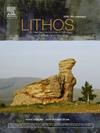镁同位素对富含碳酸盐的再循环沉积物在大陆弧环境下形成超第四纪岩浆岩过程中所起作用的制约因素
IF 2.5
2区 地球科学
Q2 GEOCHEMISTRY & GEOPHYSICS
引用次数: 0
摘要
俯冲环境中造山运动超基性岩浆的形成还不清楚,因为它需要各种共处理机制。为了解决这个问题,特别是为了研究碳酸盐变质作用在地幔源中的作用,对土耳其北部中央蓬蒂德斯弧的超基性岩浆岩进行了全岩镁-Sr-Nd同位素组成测量,这是与俯冲有关的超基性岩浆岩的罕见实例之一。这些超基性岩的(87Sr/86Sr)i(0.70461-0.70687)和εNd(t)(0.3-2.6)值相对较低,δ26Mg值(-0.73‰--0.19‰)也比正常地幔低得多。蓬莱超基性岩(PUR)的岩石学和地球化学特征表明,低δ26Mg值并不是地表风化、扩散或岩浆分异的结果,而是反映了其地幔源中存在独特的变质剂。低 Hf/Hf*、Ti/Ti*、Fe/Mn 和 Ti/Eu 比值,高 Ca/Al 和 (Na2O + K2O)/TiO2 比值,以及 δ26Mg 与 Fe/Mn 或 (Gd/Yb)N 之间缺乏显著的相关性表明,低 δ26Mg 值不能与再循环碳化蚀变岩的贡献相调和,而是由其地幔源中富含碳酸盐的沉积物所引起的。超第四纪岩石的(La/Yb)N与Ti/Eu和Hf/Sm与CaO/Al2O3的显著相关性也支持这一解释。通过对 MgSr 同位素组成的两个末端成员混合计算,可以推测 PUR 的地幔源含有不同比例的碳酸盐,主要是白云石成分。从 PUR 的微量元素组成来看,富含碳酸盐的沉积物加入地幔可能发生在 100-150 千米深处。在这方面,硅质沉积物的加入可能导致超第四纪岩石中钾和其他大离子亲岩元素的富集。同时,碳酸盐熔体可通过富含碳酸盐的沉积物在俯冲洋板块中部分熔化而形成,然后与上覆地幔反应形成碳酸盐化橄榄岩,成为低δ26Mg、低硅和高LREEs的超基性岩的来源。这项研究首次报告了在大陆弧环境中形成的超基性岩的镁同位素数据,并证明富碳酸盐沉积物在形成这类岩石的过程中发挥了重要作用。未来的工作需要检验这一过程在大洋弧和大陆弧环境中是否常见。本文章由计算机程序翻译,如有差异,请以英文原文为准。
Magnesium isotope constraints on the role of recycled carbonate-rich sediments in the formation of ultrapotassic magmatic rocks at a continental arc setting
The formation of orogenic ultrapotassic magmatism in a subduction setting is still unclear as it requires various co-processing mechanisms. To address this problem, especially to investigate the role of carbonate metasomatism in the mantle source, whole-rock Mg-Sr-Nd isotopic compositions have been measured for ultrapotassic magmatic rocks from the Central Pontides arc, northern Turkey, one of the rare examples of subduction-related ultrapotassic magmatism. These ultrapotassic rocks have relatively low (87Sr/86Sr)i (0.70461–0.70687) and εNd(t) (0.3 to 2.6) values and display much lower δ26Mg values (−0.73 ‰ to −0.19 ‰) than the normal mantle. The petrological and geochemical characteristics of the Pontide Ultrapotassic rocks (PUR) indicate that the low δ26Mg values do not result from surficial weathering, diffusion, or magmatic differentiation, but rather reflect the presence of distinct metasomatizing agent in their mantle source. The low Hf/Hf*, Ti/Ti*, Fe/Mn and Ti/Eu ratios, high Ca/Al and (Na2O + K2O)/TiO2 ratios, and lack of significant correlations between δ26Mg and Fe/Mn or (Gd/Yb)N suggest that the low δ26Mg values cannot be reconciled with the contribution of recycled carbonated eclogites, but are induced by the addition of carbonate-rich sediments to their mantle source. This interpretation is also supported by the significant (La/Yb)N vs. Ti/Eu and Hf/Sm vs. CaO/Al2O3 correlations for the ultrapotassic rocks. Using two end-member mixing calculations of Mg![]() Sr isotopic compositions, the mantle source of PUR is constrained to contain varying proportions of carbonates, mostly of dolomite composition. The addition of carbonate-rich sediments to the mantle may have occurred at depths of 100–150 km as indicated by the trace element compositions of PUR. In this regard, the enrichment of K and other large ion lithophile elements in the ultrapotassic rocks can be induced by the contribution of silicic sediments. Meanwhile, carbonatitic melts can be formed through the partial melting of carbonate-rich sediments in the subducting oceanic slab, which then reacts with the overlying mantle to form carbonated peridotite that serves as the source of ultrapotassic rocks with low-δ26Mg, low-silica, and high LREEs. This study reports for the first time the Mg isotope data of ultrapotassic rocks formed in a continental arc setting and documents that carbonate-rich sediments play an important role in creating such rocks. Future work is needed to test whether this process is common in both oceanic arc and continental arc settings.
Sr isotopic compositions, the mantle source of PUR is constrained to contain varying proportions of carbonates, mostly of dolomite composition. The addition of carbonate-rich sediments to the mantle may have occurred at depths of 100–150 km as indicated by the trace element compositions of PUR. In this regard, the enrichment of K and other large ion lithophile elements in the ultrapotassic rocks can be induced by the contribution of silicic sediments. Meanwhile, carbonatitic melts can be formed through the partial melting of carbonate-rich sediments in the subducting oceanic slab, which then reacts with the overlying mantle to form carbonated peridotite that serves as the source of ultrapotassic rocks with low-δ26Mg, low-silica, and high LREEs. This study reports for the first time the Mg isotope data of ultrapotassic rocks formed in a continental arc setting and documents that carbonate-rich sediments play an important role in creating such rocks. Future work is needed to test whether this process is common in both oceanic arc and continental arc settings.
求助全文
通过发布文献求助,成功后即可免费获取论文全文。
去求助
来源期刊

Lithos
地学-地球化学与地球物理
CiteScore
6.80
自引率
11.40%
发文量
286
审稿时长
3.5 months
期刊介绍:
Lithos publishes original research papers on the petrology, geochemistry and petrogenesis of igneous and metamorphic rocks. Papers on mineralogy/mineral physics related to petrology and petrogenetic problems are also welcomed.
 求助内容:
求助内容: 应助结果提醒方式:
应助结果提醒方式:


